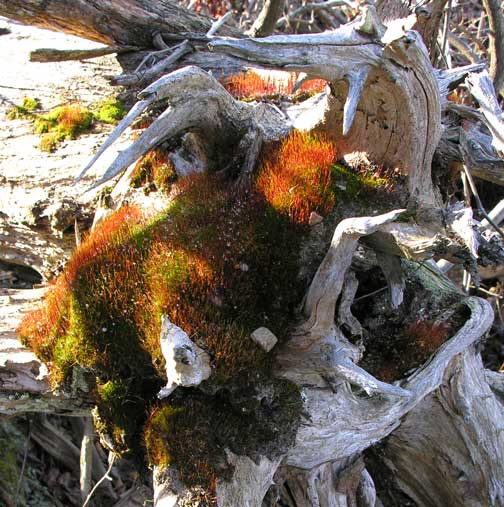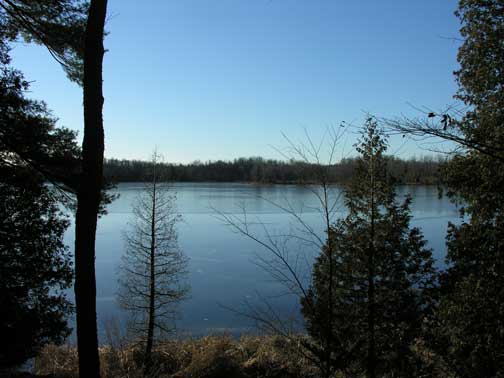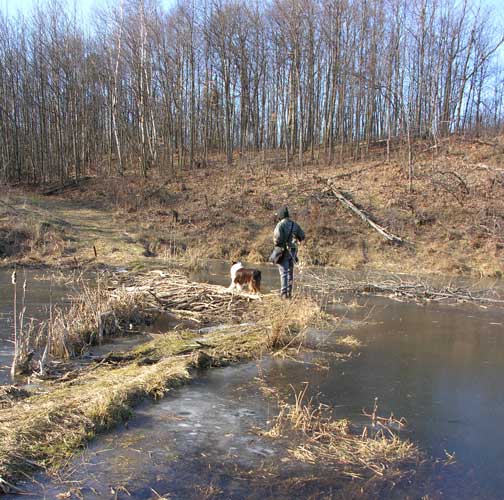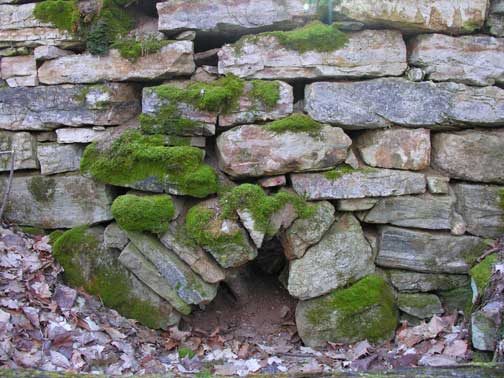January 22nd, 2007
along the lime kiln trail at mill pond conservation area
Yesterday, I said I’d put up something nice for those who didn’t appreciate the post about spiders, so consider this to be it. About a week ago, we spent a couple of hours hiking the Lime Kiln Trail at Mill Pond Conservation Area which lies a few miles south of Smiths Falls. I shot quite a few photos that day – perhaps the most I’ve taken in one day in awhile. The circumstances were unusual for mid-January. No snow on the ground and just the slightest film of ice forming on most of the larger ponds and in the roughly horseshoe-shaped shallow lake that loops around much of the conservation lands. The above photo is a view of one section of the lake. In summer, we occasionally paddle our canoe around the shoreline of the lake and into a couple of very shallow bays populated by the bleached stumps of long submerged trees. We can easily spend 2 or 3 hours paddling and then drifting here and there while I photograph dragonflies, waterlilies and other interesting things. Actually, I just checked and see that I wrote about paddling there on July 30th, 2006.
As mentioned, the most striking thing about our hike was that there was not a flake of snow on the ground. I can’t tell you how odd that seems in mid-January when we would usually be snowshoeing or perhaps just struggling along in our boots along trails covered by a foot or more of snow. Instead, this is how it looked as we set out on the trail that runs along a high ridge above a large beaver pond (click on all images for larger views).
We stopped at the pond to take a look around. I shot a series of photos and have stitched them into a panorama. Just click on the above mini-panorama to see the larger view. Last year around this date, we walked out across the pond, checking out the beaver lodges and other activity. This year, only the very edge of the pond had a bit of thin ice forming. Out across the pond, we could see a new lodge that probably wasn’t there last year.
 While standing beside the pond, I noticed the most brilliant miniature “landscape” of fire moss (probably Ceratodon purpureus) carpeting a weathered cedar root. Further along the trail, we saw other interesting things that would normally be covered by snow at this time of the year, such as this verdant club moss — probably Shining Club Moss (Huperzia lucindula).
While standing beside the pond, I noticed the most brilliant miniature “landscape” of fire moss (probably Ceratodon purpureus) carpeting a weathered cedar root. Further along the trail, we saw other interesting things that would normally be covered by snow at this time of the year, such as this verdant club moss — probably Shining Club Moss (Huperzia lucindula).
Along the trail above the beaver pond, I was reminded of something I’ve been meaning to check on for awhile. Most of the trees in a large stand growing in a ravine are marked with large numerals in blue paint. I must make an enquiry about this and shall try to remember to post the reply.
Continuing further along the trail, we came to the low beaver dam over which the hiking trail passes. Sabrina and Don headed out across while I shot a few photos (see above). However, Sabrina stopped in her tracks a split second after I shot this photo. There was water moving through the sticks as the pond level was much higher than would usually be seen at this time of the year. She paused for a moment and then retreated, leaving Don standing on the dam trying to decide what to do. I called out that maybe it wasn’t safe as Sabrina is pretty savvy about such things. However, Don decided to forge ahead on his own. A moment after I shot the prevous linked photo, Don also decided that the path over the dam was too risky after some stick shifted and sank. In mid-January, slipping and falling into freezing water while out on a trail is not worth experiencing, so we decided to circle around downstream following a trail probably made by the deer and beaver that frequent this area. It made for a nice detour as the stream was still open with water flowing over rocks before emptying out into the larger pond we had passed earlier in our hike.
Just a short distance beyond the beaver dam, there’s a short side trail that leads to the lime kiln for which this trail is named. There are quite a lot of these scattered over the countryside. If you’re not familiar with the term, here’s a bit of info. The one in the above photo is just the simple kind that is usually found on homesteads in this region. The one at Mill Pond would most resemble a smaller version of the drawing on this page (look most of the way down the page). The kiln at mill pond is about 3 meters (10 feet) in diameter. This is how it looks when viewed from above.
From the lime kiln, we continued on along the trail, stopping to view other small things of interest along the way. I’ve a selection of my favourite shots in this gallery of my online photo galleries. We’re hoping to get back to Mill Pond again in the next couple of weeks to walk on the pond once it is frozen solid — which seems likely now that we’re finally getting some weather more characteristic of winter.
Note: for those who might be interested, here’s a .pdf map of the Mill Pond Conservation Area. We hiked the trail that goes by the lime kiln (marked in yellow), but also the dotted trail that goes out onto that long peninsula.




January 22nd, 2007 at 4:25 pm
That’s a great place for a good long hike. I am curious about your panorama shot. Did you bring a tripod to keep the camera at the same height and angle? Whenever I try to capture a panoramic moment, my handheld shots always seem to produce something that reveals the stitching. Love that miniature landscape. It’s like a view of a forested earth from a distance.
January 22nd, 2007 at 4:33 pm
robin – I just shot that handheld. I didn’t spend much time with the stitching this time either as you can see if you study the foreground a bit — there are a few branches going off into nowhere. I just replaced the link to the smaller version with a larger one “original” on PBase, so you might not have seen that. The original size is too big for most screens but shows the view off better. When I shoot for panorama, I try to keep the camera at as close to the same height in front of me as possible, and just turn the camera in my hands as though it were on a tripod. Btw, I’m just too lazy to carry a tripod around with me, so all of my shooting is handheld. I loved that little landscape too. What was incredible about it was the brilliance. It very much caught my eye from a distance — almost as though someone had left a scarlet piece of velvet draped over that tree root. I don’t think I’ve ever seen fire moss looking so bright and must attribute that to the moisture and cold without freezing this winter.
January 23rd, 2007 at 1:17 am
Let me know the next time you’re going on one of these hikes. Maybe I can tag along.
January 23rd, 2007 at 1:50 am
pablo – We do a hike like this at least once or twice a week, so just drop by and you’re most welcome to tag along! (-:
May 9th, 2007 at 10:34 am
I was just checking out what you have on the mill pond . very nice . But I was wondering if you knew about the tremendos fly fishing that Mill Pond has to offer as well? My name is James and i have fallen for the mill pond . This little body of water is just out standing and easy to access do to the sise and shape. This allows us small boats and canoues’s to use it .The shape allows you to find a nice spot to cast out of the wind for the mill ponds many sport fish. The pond has everything from pan fish to bass and pike. I think that this is a grate spot to bring your family because every one can find thier own adventure and take home thier own memories of this beautifle pure land.
May 9th, 2007 at 11:08 am
James – Hi! I don’t fish (I’m a vegetarian), but I always figured that the fishing must be pretty decent as I see a lot of fish when paddling around in my canoe. Also the Osprey with the nest on one of the islands seem to do quite well at their fishing. I very much agree that it’s a great spot. I’m glad that it’s shallow enough that it doesn’t get large boats on it – and that they are supposed to be prohibited. There are enough places for large boats to go without being on one of the few smaller lakes where it is nice to have things relatively quiet.